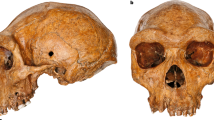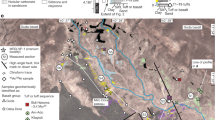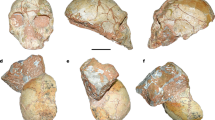Abstract
One of the most contentious topics in the study of human evolution is that of the time, place and mode of origin of Homo sapiens1,2,3. The discovery in the Northern Danakil (Afar) Depression, Eritrea, of a well-preserved Homo cranium with a mixture of characters typical of H. erectus and H. sapiens contributes significantly to this debate. The cranium was found in a succession of fluvio-deltaic and lacustrine deposits and is associated with a rich mammalian fauna of early to early-middle Pleistocene age. A magnetostratigraphic survey indicates two reversed and two normal magnetozones. The layer in which the cranium was found is near the top of the lower normal magnetozone, which is identified as the Jaramillo subchron. Consequently, the human remains can be dated at ∼1 million years before present.
This is a preview of subscription content, access via your institution
Access options
Subscribe to this journal
Receive 51 print issues and online access
$199.00 per year
only $3.90 per issue
Buy this article
- Purchase on Springer Link
- Instant access to full article PDF
Prices may be subject to local taxes which are calculated during checkout



Similar content being viewed by others
References
Bräuer, G., Yokoyama, Y., Falguères, C. & Mbua, E. Modern human origins backdated. Nature 386, 337–338 (1997).).
Ward R. & Stringer C. Molecular handle on the Neanderthals. Nature 388, 225–226 (1997).
Bermúdez de Castro, J. M. et al. Ahominid from the lower Pleistocene of Atapuerca, Spain: possible ancestor to Neanderthals and modern humans. Science 276, 1392–1395 (1997).
Bannert, D. et al. Zür Geologie der Danakil Senke (Nördliches Afar Gebiet) NE Aethiopien. Geol. Rundsch. 59, 409–443 (1970).
Brinckmann, J. & Kürsten, M. Geological Sketchmap of the Danakil Depression(Bundesanstalt für Bodenforshung, Hannover, 1970).
Barberi, F. & Varet, J. Volcanism of Afar: small-scale plate tectonics implications. Geol. Soc. Am. Bull. 88, 1251–1266 (1977).
Merla, G. et al. Geological Map of Ethiopia and Somalia 1:2,000,000 and Comment with a Map of Major Landforms(Centro Stampa, Firenze, 1979).
Garland, C. R. Geological Survey of Ethiopia Memoir Vol. 1(Berhanena Selam, Addis Ababa, 1980).
Kalb, J. E. et al. Geology and stratigraphy of Neogene deposits, Middle Awash valley, Ethiopia. Nature 298, 17–25 (1982).
Berggren, W. A., Kent, D. V., Swisher III, C. C. & Aubry, M.-P. Arevised Cenozoic geochronology and chronostratigraphy. SEPM (special publ.) 54, 129–212 (1995).
Wood, B. Koobi Fora Research Project Vol. 4,Hominid Cranial Remains(Clarendon, Oxford, 1991).
Tobias, P. V. Olduvai Gorge Vol. 4 V-IX.,The Skull, Endocasts and Teeth of Homo habilis(Cambridge University Press, 1991).
Wolpoff, M. H. Human Evolution(McGraw-Hill, New York, 1997)
Clark, J. D. et al. African Homo erectus: old radiometric ages and young Oldowan assemblages in the Middle-Awash valley, Ethiopia. Science 264, 1907–1909 (1994).
Acknowledgements
All fossils are stored at the Eritrea National Museum, Asmara; inventory numbers refer to the provisional catalogue. We thank M. Pickford and T. D. White for discussions about the fossil record; M. R. Gibling, I. P. Martini, P. Passerini and A. Turner for critical reading of an earlier manuscript; A. Kibrab (Eritrea Department of Mines) and Y. Libsekal (Eritrea National Museum) for assistance in Eritrea; and F. Heller (ETH Magnetic Laboratory, Zurich). This work was supported by the Italian CNR (Cultural Heritage and TRANSRIFT projects), the PeriTethys Programme, the European Commission, the University of Florence, and the Italian Ministry for Foreign Affairs.
Author information
Authors and Affiliations
Corresponding author
Rights and permissions
About this article
Cite this article
Abbate, E., Albianelli, A., Azzaroli, A. et al. A one-million-year-old Homo cranium from the Danakil (Afar) Depression of Eritrea. Nature 393, 458–460 (1998). https://doi.org/10.1038/30954
Received:
Accepted:
Issue Date:
DOI: https://doi.org/10.1038/30954
This article is cited by
-
Sally C. Reynolds & René Bobe (Eds.): African Paleoecology and Human Evolution
African Archaeological Review (2023)
-
The Western Periphery of the Red Sea as a Hominin Habitat and Dispersal Corridor: Marginal or Central?
Journal of World Prehistory (2021)
-
A two-million-year-long hydroclimatic context for hominin evolution in southeastern Africa
Nature (2018)
Comments
By submitting a comment you agree to abide by our Terms and Community Guidelines. If you find something abusive or that does not comply with our terms or guidelines please flag it as inappropriate.



